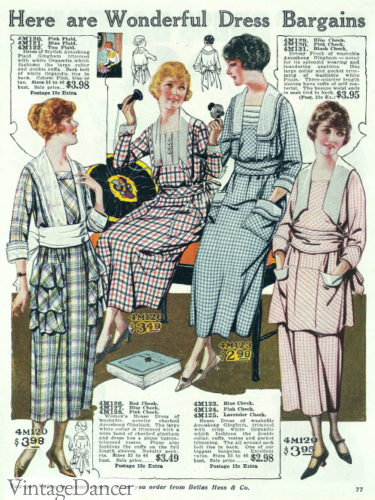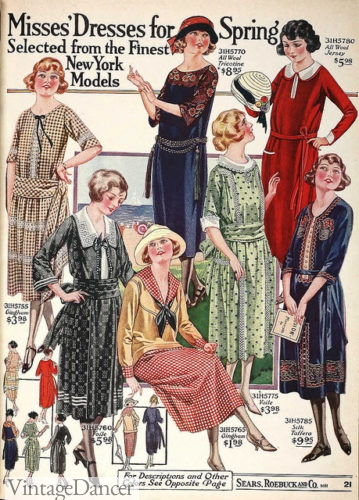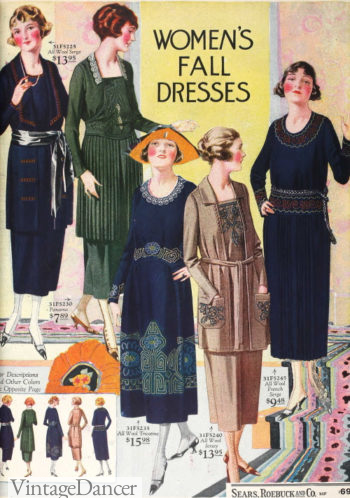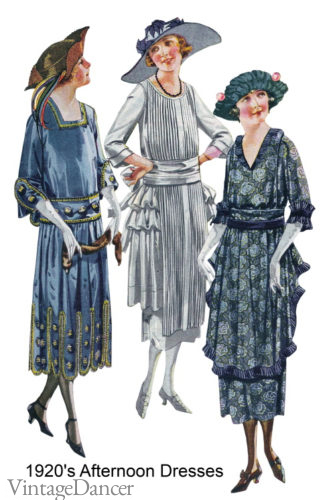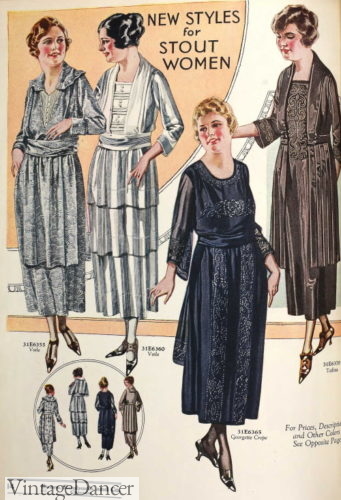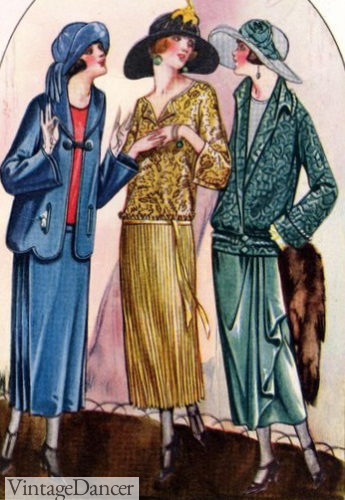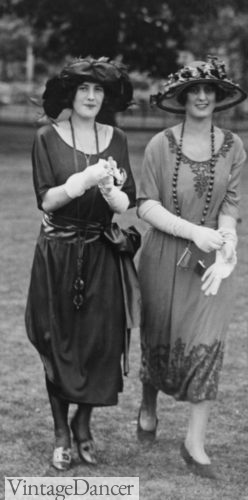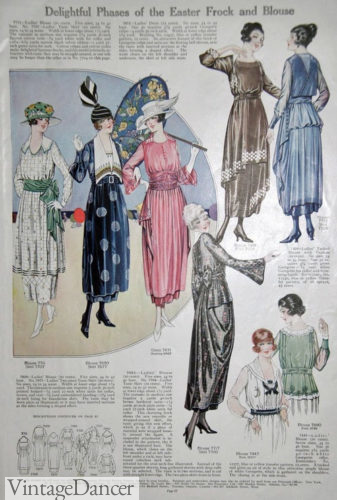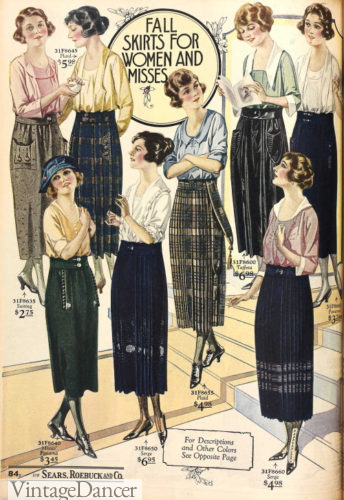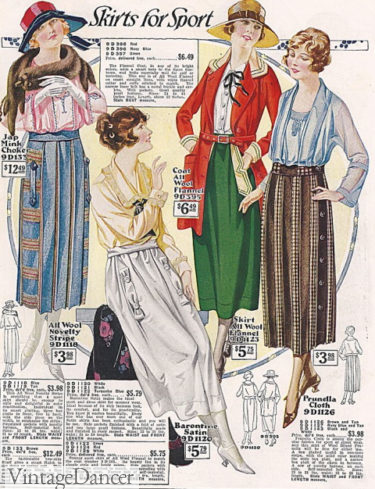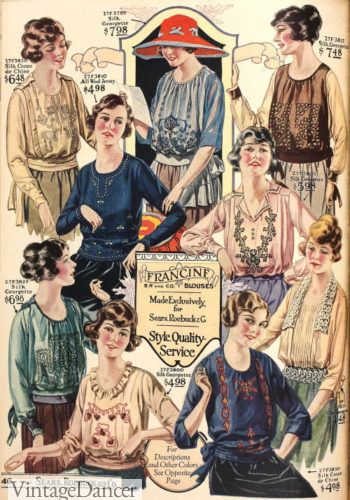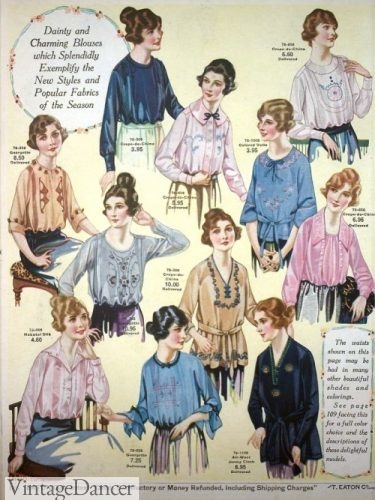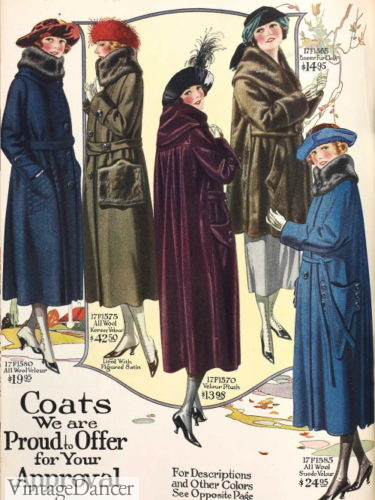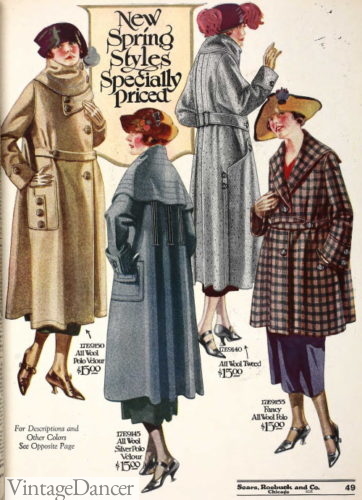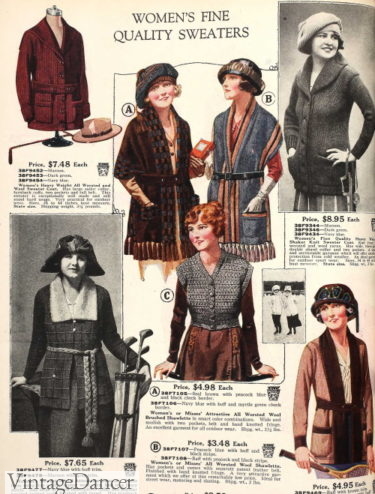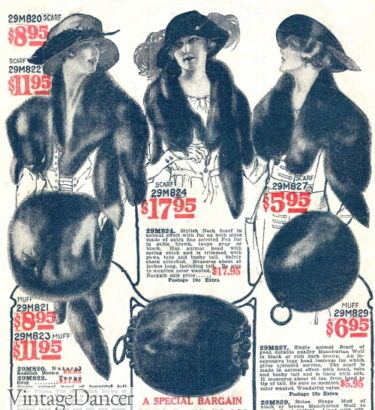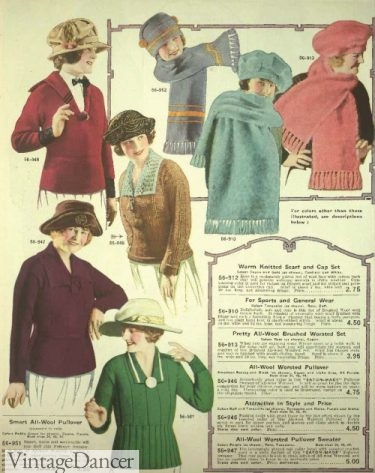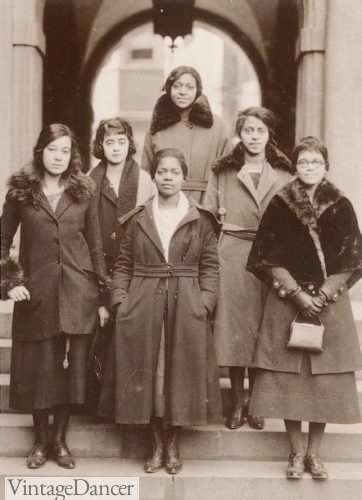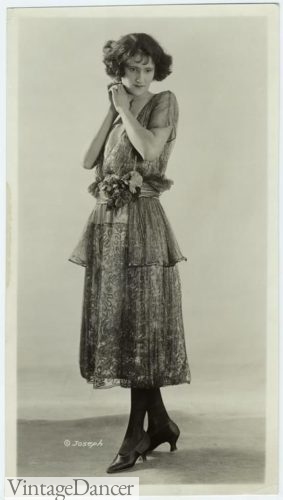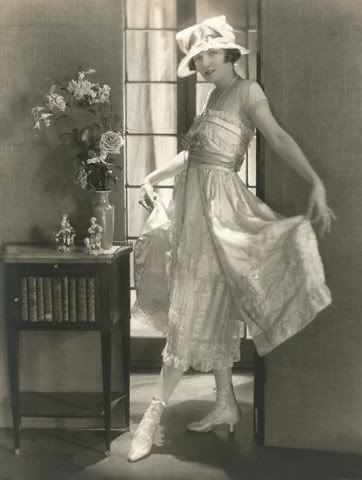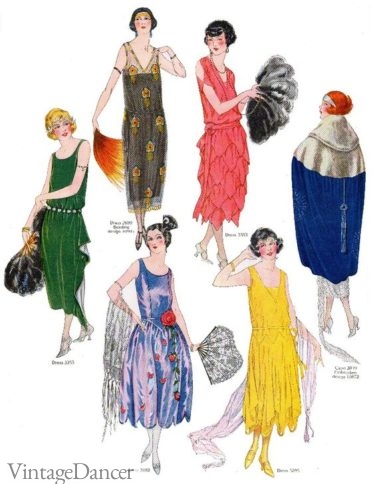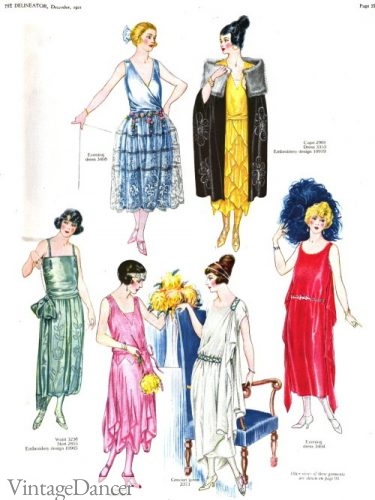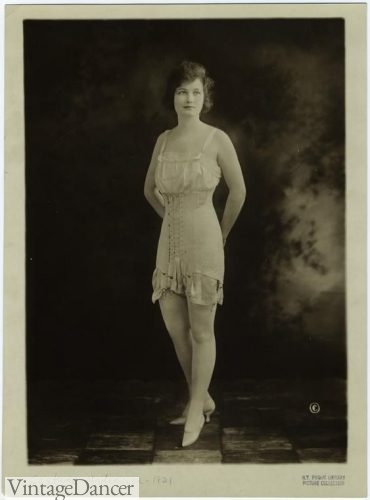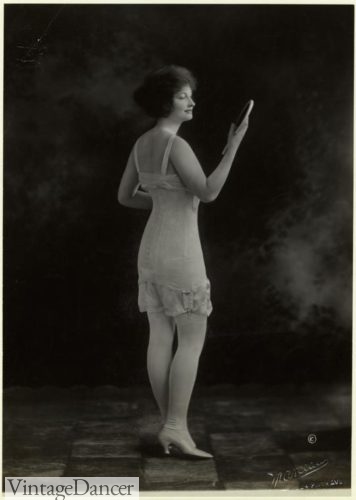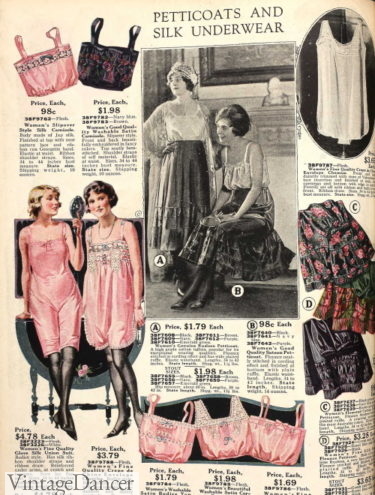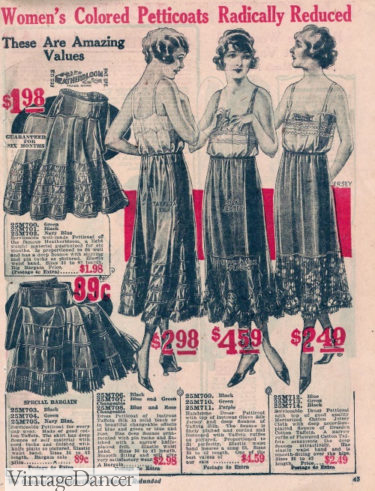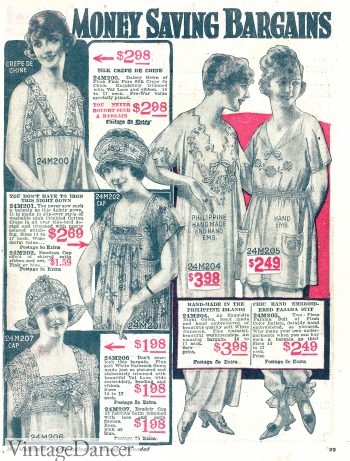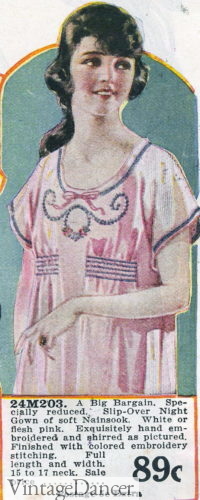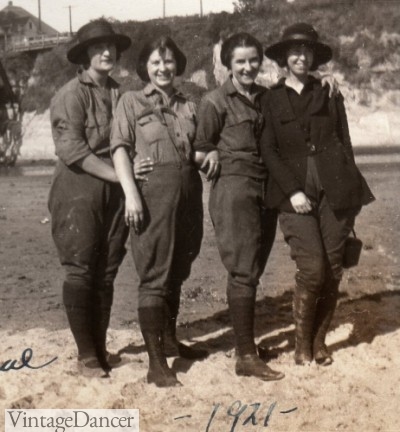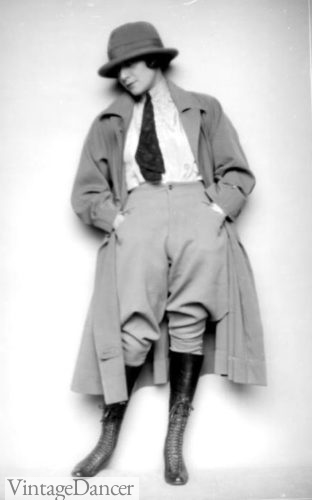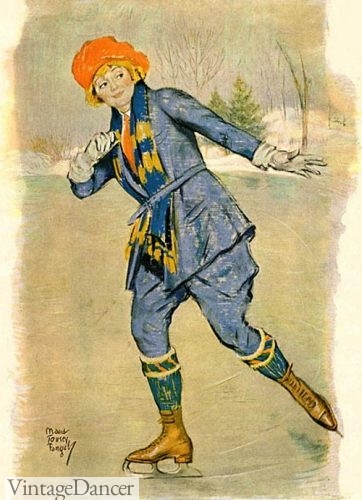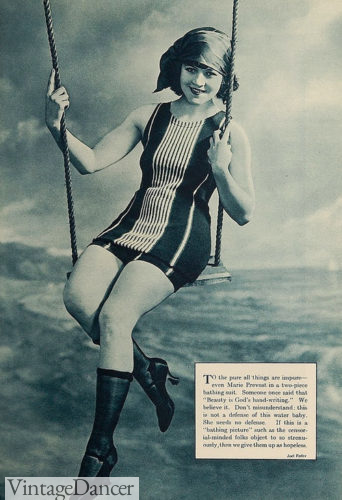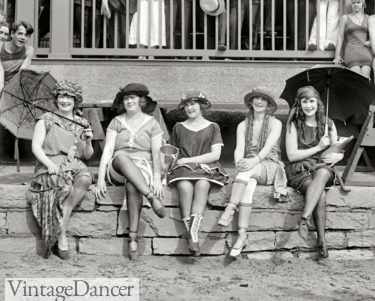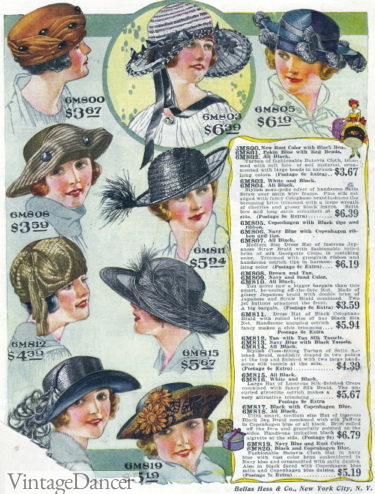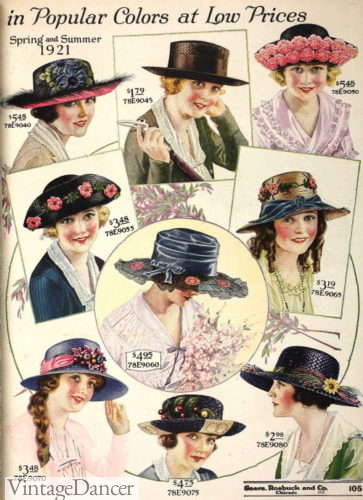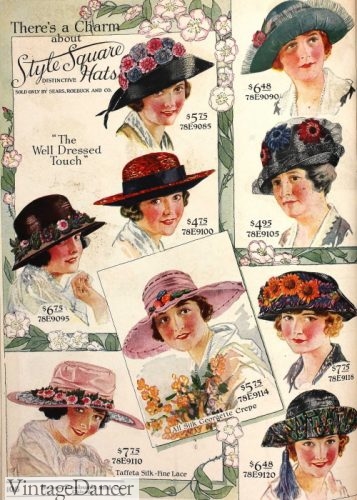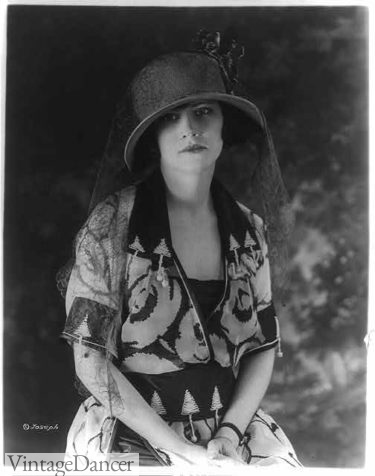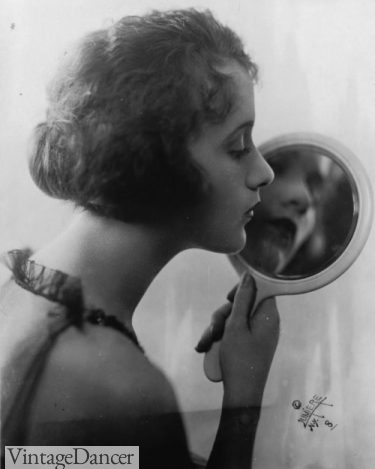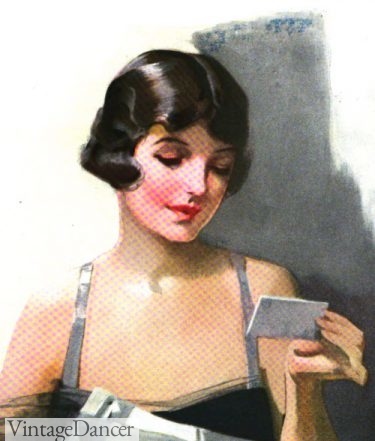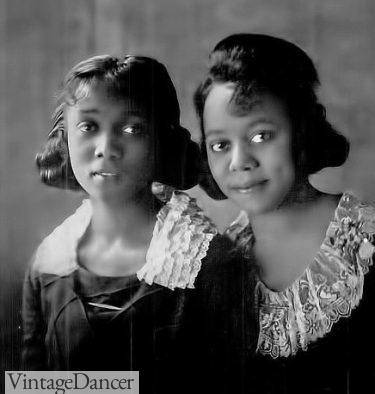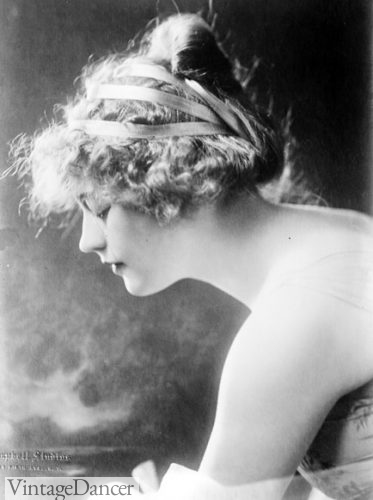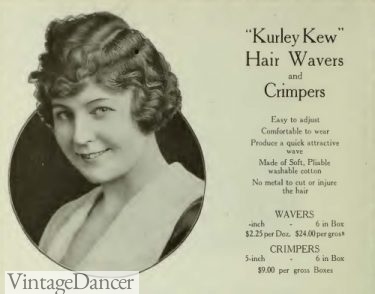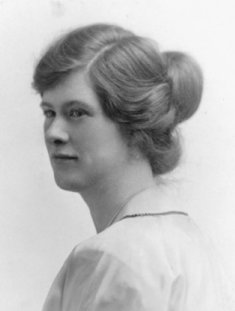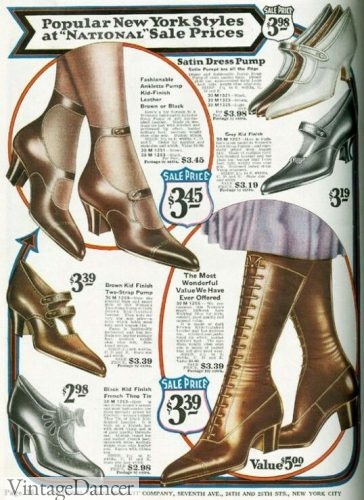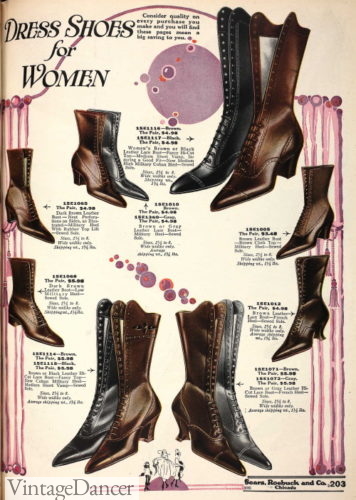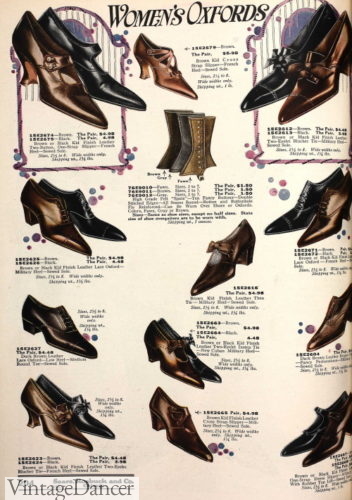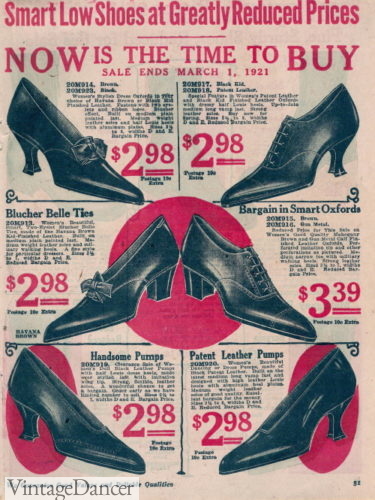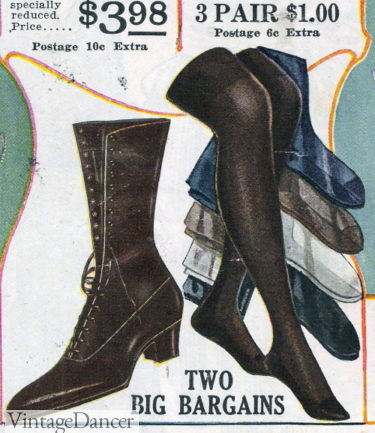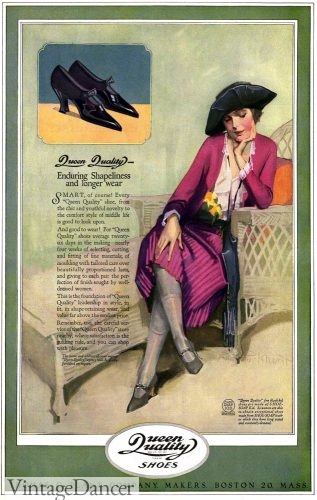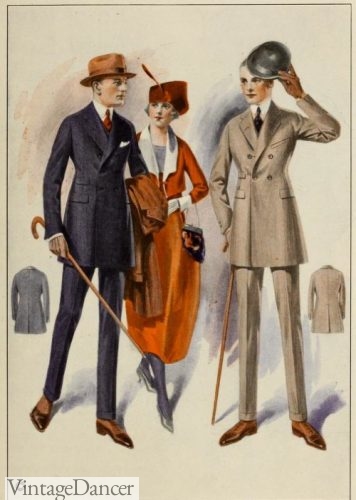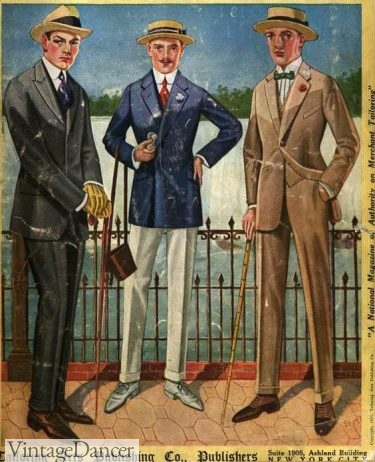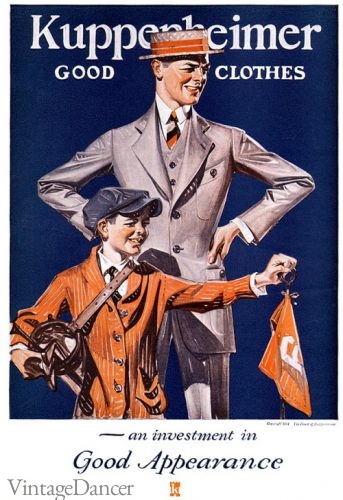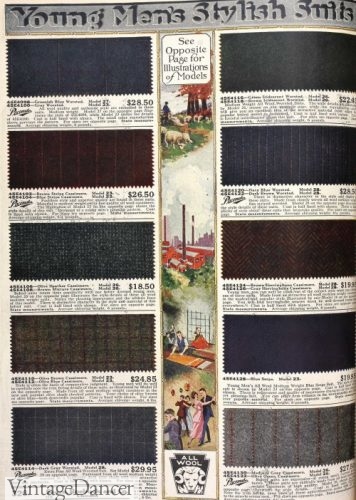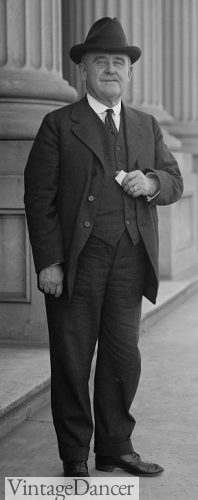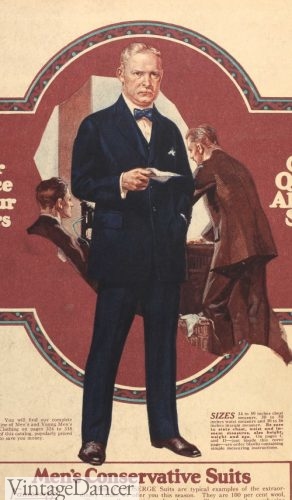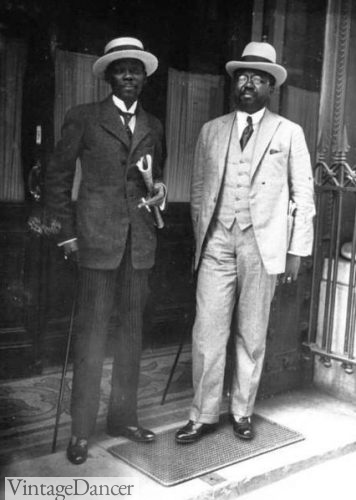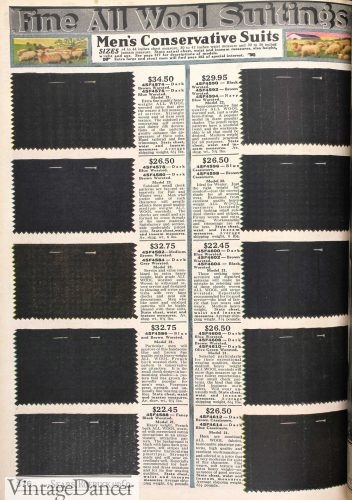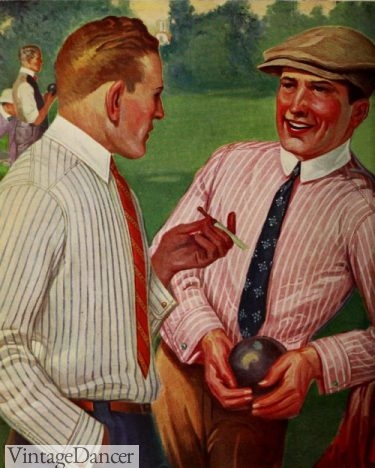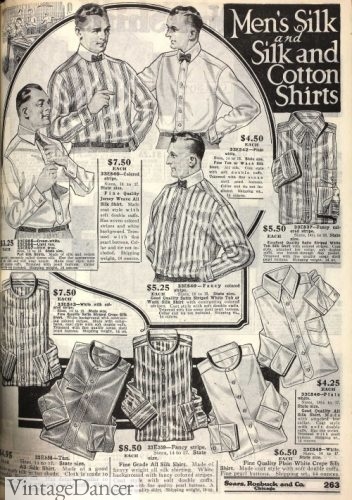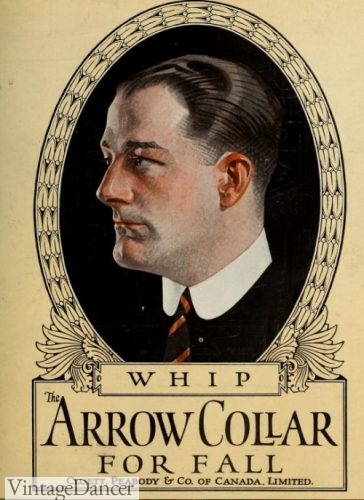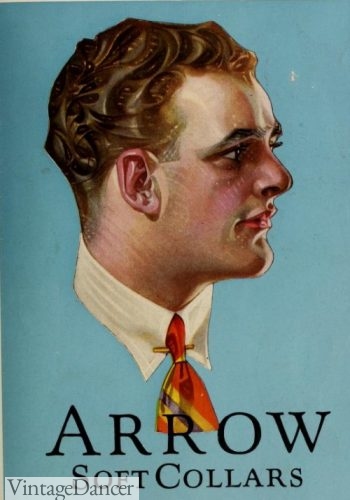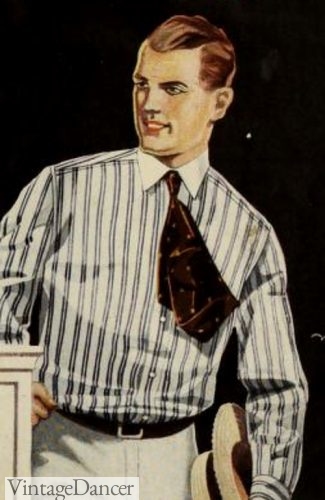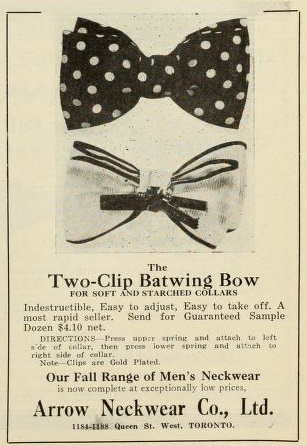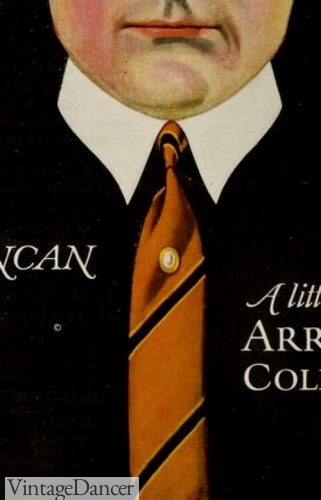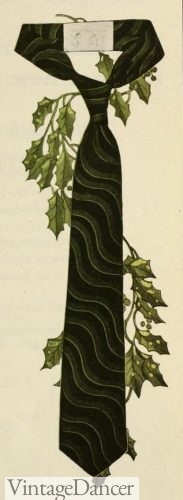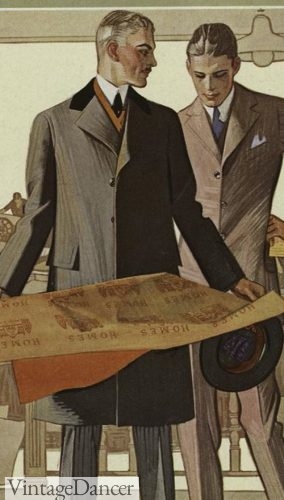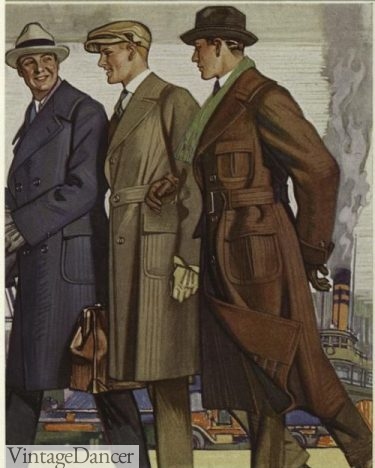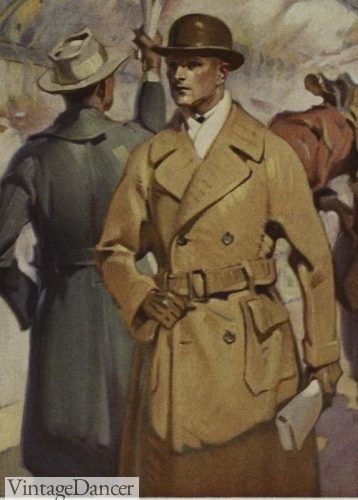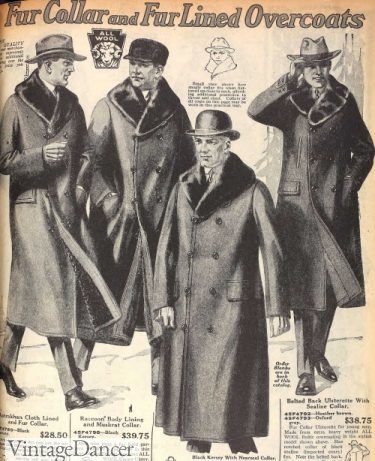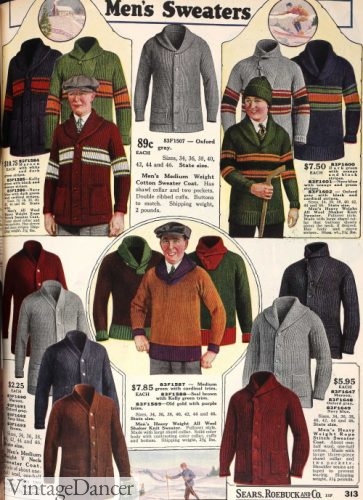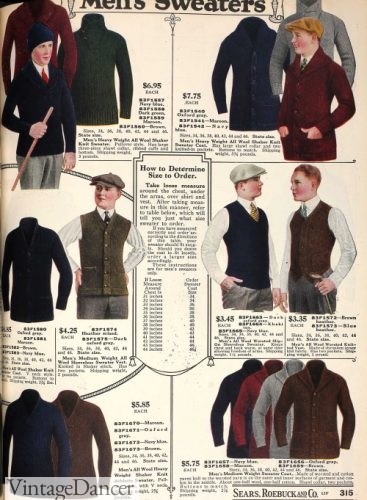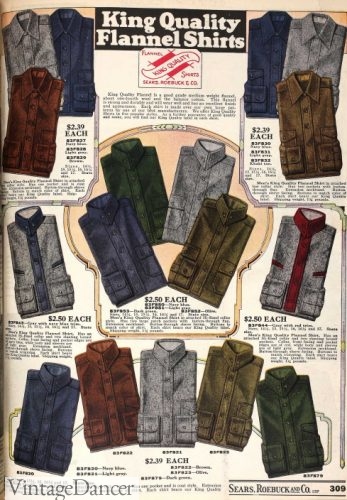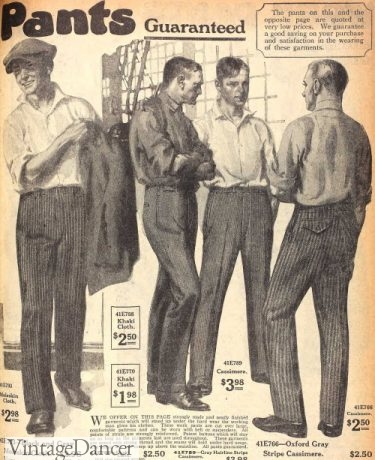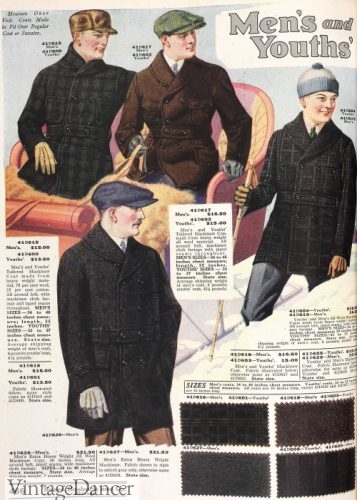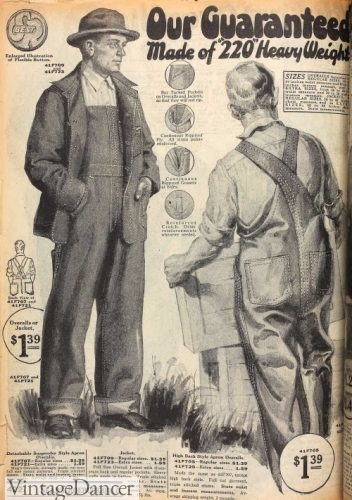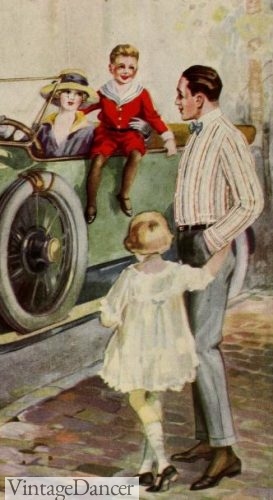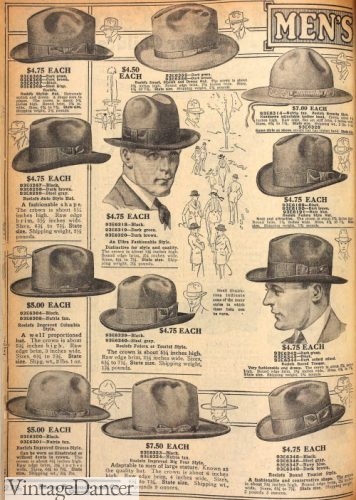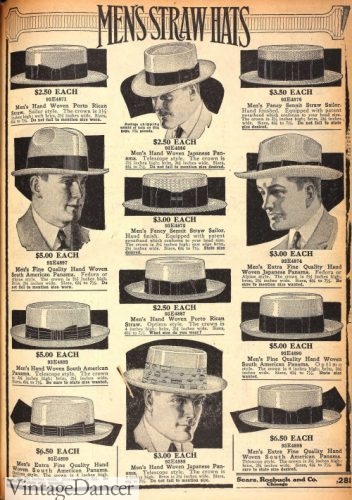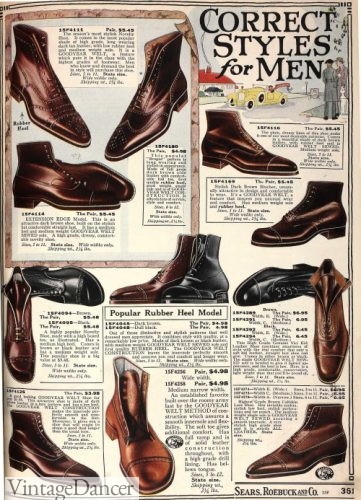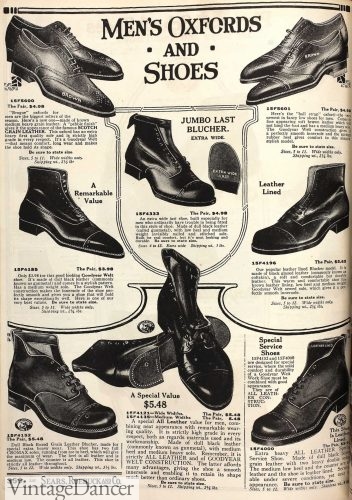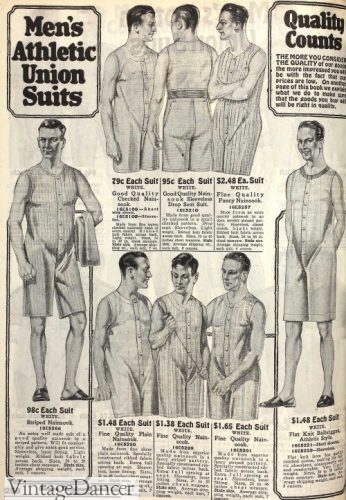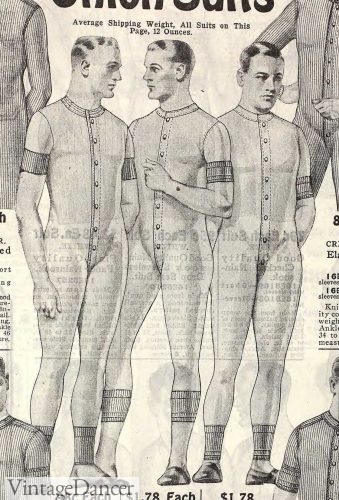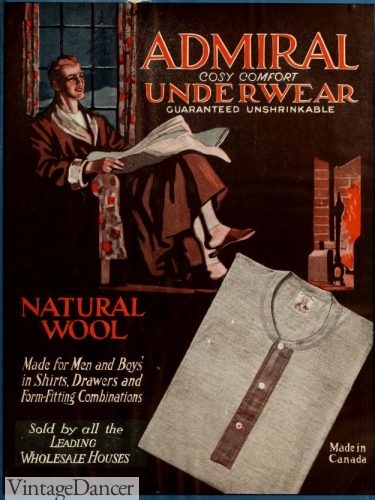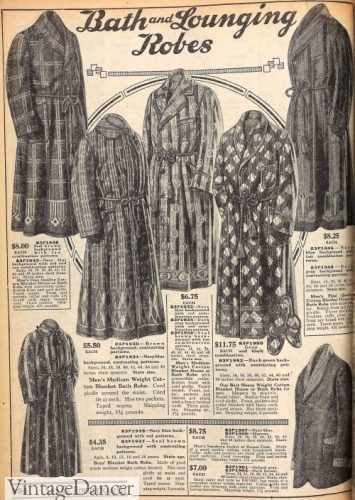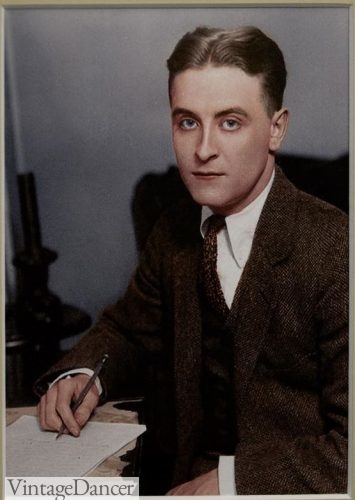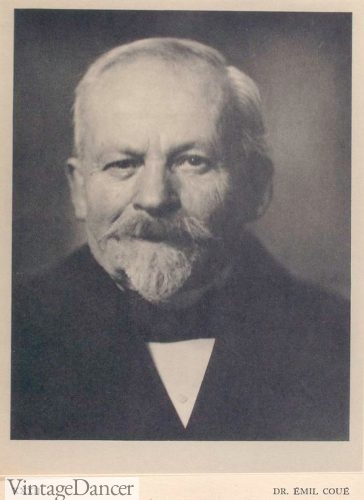A new year in the ’20s is cause for celebration. Last year we looked back at fashion in the year 1920, and saw that is wasn’t quite what we think of as 1920s fashion. No flappers, no fringe, no gangsters… not yet. The early 1920s were still recovering from World War 1. Fashions of the day reflected the need for simple, comfortable, wearable fashions that didn’t need the help of a maid to put on. In 1921 the same clothing continued from the previous few years. It wouldn’t be ’till next year, 1922, that the roaring twenties became the Jazz Age.
So what did fashion look like 100 years ago from 2021? Follow along as we re-visit 1921 fashions for women and men. And find out why many of these style are coming back in fashion today.
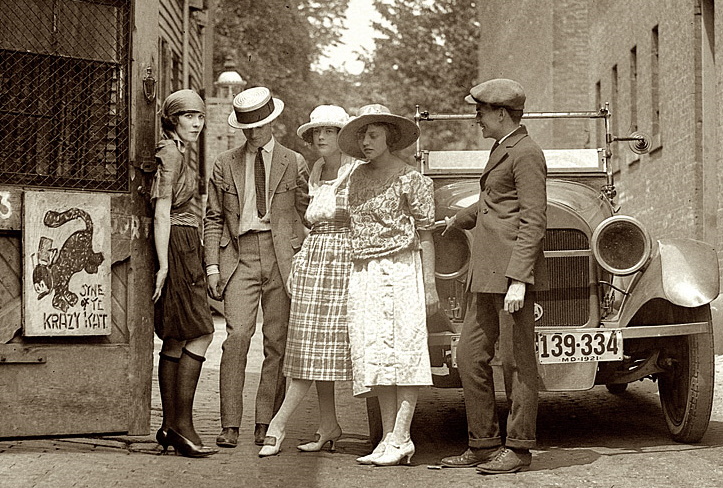
1921, visiting the Krazy Kat club in Washington D.C., wearing common daywear at that time
Daywear- Dresses
Dresses were the one item women wore all day from sun up to sundown. Wealthier women had a dress for different times of the day and special activities while poor women had only one day dress and one nicer dress worn on Sundays only.
Dresses hung to almost mid-calf, a hemline that revealed ankles and pretty shoes, after a century of being covered up by lace up granny boots. Most were long sleeve or 3/4 sleeve, even in summer. Necklines were modest but again more revealing than the Edwardian era. Round boat necks, scoop necks, or smaller squared neckline were accented by oversized collars, thin bows, decorative embroidery, and other trim that called attention to the neck and face.
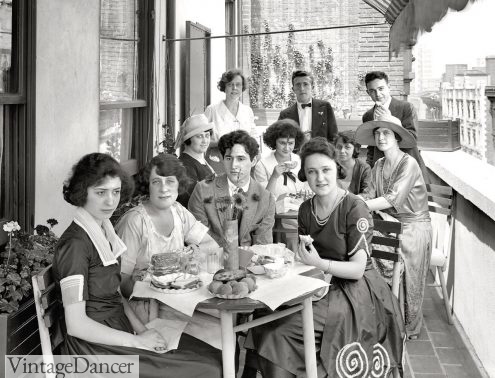
Brunswick Records employees’ luncheon, New York, 1921
Cotton house dresses were the simplest of all the dresses but also the most cheerful with small patterns- checks, polka dots, and plaid. They had long shawl collars or round peterpan collars in white. Dresses had a wide matching sash band or narrow tie belt centered around the mid waist.
Daytime dresses or outing dresses had similar shapes as house dresses but came in solid colors or larger patterns with more detailed embroidery and trim around collars, pockets, belts and hemlines. Fabrics were richer silks, velvet, wool and sheer cottons in the summer. The dressiest of dresses were worn to church, garden parties, dinner and dancing occasions.
The overalls looseness of 1921 dresses made them extremely comfortable to wear. They could be made with only a few yards of fabric making them affordable to all classes to sew at home. A store bought dress was a bit more expensive with prices from $4-10 US dollars or $58-148 in 2020 USA currency.
- 1921 house dresses with tunic effect and large collars
- 1921 house and day dress from casual to dressy
- 1921 fall winter dresses
- 1921 afternoon dresses
- 1921 plus size dresses (stout)
- 1921 fall afternoon attire
- Cynthia Noble (left) with Peggy Lewis and Mr Priesworth at a polo pony show at the Ranelagh Club in Barnes, West London, June 1921. (Photo by Topical Press Agency/Hulton Archive/Getty Images)
- 1921 day to afternoon fashion
The Netflix series Morocco: Love in Times of War (Spanish with subtitles or dubbing) is set in 1921. The costumes seem fairly well done and reflective of Spanish fashion in 1921. Ignore their hair and makeup which is never accurate in TV/Movies. Here are more films set in 1921 to watch.
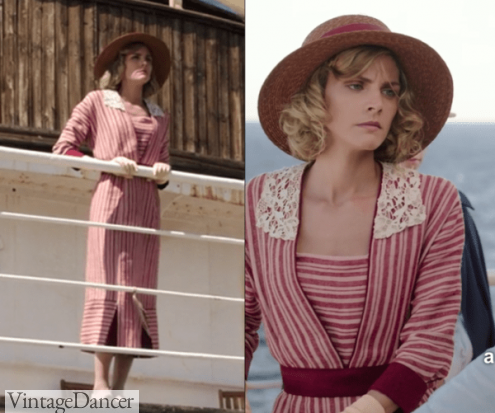
Morocco: Love in Times of War set in 1921
Daywear – Separates
The trend for skirt and blouse separates continued to grow in 1921. Skirts were simple shapes of lightly gather or box pleated waistbands with a full hip and slight tapered to the shin. Oversized pockets created the doll-like appearance on women of all ages and sizes.
Blouses, in my opinion, were the prettiest of all tops in new century. Sheer fabrics were delicately embroidered with designs inspired by porto rican folk art. They had a peasant class look but with buttery soft luxury fabrics. The fit was loose enough to drape off the shoulders, tucked into the waist, and “bloused” out enough to obscure a defined waist.
The first picture below went a little viral on Instagram when I asked “I could see these style being worn today. Do you?” The answer was an overwhelming yes. While these looks are not mainstream yet the desire is there and some pieces are trending already in the #cottagecore style. Will 1921 fashion be returning in 2021? I think so.
- 1921 skirts and blouses
- 1922 spring and summer skirts
- 1921 fall blouses
- 1921 Blouses
Daywear – Outerwear
Over blouses and dresses could come a warm knit sweater, long cardigan or large scarf. Knitwear had been making its way out of the realm of underwear only and into fashionable attire for a few years already.
As the 20s pursued casualness more aggressively, knitted sweaters were being worn in place of jackets in everyday life. Solid colors, longer hip lengths, and matching knit belts made cardigan sweaters almost identical to men’s versions. Pullover sweaters had a more girlish fit with a wide waistband, wide collars, and pom poms dangling from the V necklines. I must have one!
Winter overcoats really made women look like China dolls. Oversized collars, pockets, and buttons on plush velour or heavy wool coating diminished women’s size and shape back to that of little girl childness. The twenties are marked as the era of La Garconne, the boy-ish shape, but it really began with mimicking little girls fashion.
The only adult flare added to outerwear was the heavy use of real furs. Large fur trimmed collars kept necks warm and cuffs kept the wind out of sleeves. Whole head fox fur stoles draped over shoulders or circled into hand muffs. Everyone women sought to look rich with whatever real or faux fur she could afford.
- 1921 overcoats
- 1921 Spring coats
- 1921 knitwear- sweaters, cardigans and shawls
- 1921 fur stoles and muffs
- 1921 sweaters and scarves
- 1921 U Penn Gamma Chapter Ladies, 1921, led by Sadie Alexander (Left in Glasses)
Evening Gowns
Specialty evening gowns were for the ultra rich, movie stars, and fashionable city-dwellers who had more places to wear such gowns. Regular folk would wear their best afternoon frock for evening events.
The full skirt or pannier hip flounces remained popular in 1921. Lavin spearheaded the Robe de Style gowns which were copied by other designs. Lanvin continued the style, while other designers preferred the straightline, long, and shiny Grecian inspired dress.
Lace shawls, ostrich feather handfans, velvet opera coats were essential accessories.
- 1921 soutache trimmed party dress
- 1921 Irene Castle, dancer, wears a light taffeta dress over a cream tulle and lace underskirts
- 1921 evening dresses and an opera coat
- 1921 evening dresses
Underwear and Sleepwear
Lingerie supported outerwear while also being free from the 6 or more underlayers required just 10 years prior. Most women wore a “combination” chemise + bloomers, topped with a corset, slip and a petticoat to add a bit of fulness in the skirt. Corsets were not necessary for thin women or young women who found them hindering to their dance moves. For these women, the bust flattening Brassiere was the latest and greatest lingerie piece.
- 1921 lingerie with corset
- 1921 lingerie with corset back view
- 1921 lingerie, bra, petticoats, step-ins
- 1921 black, Navy blue, green or purple taffeta or silk petticoats
Stockings rolled up and clipped to garters were usually black for daywear and sometimes white for summer or evening attire.
Women had to wear stockings with all types of dress. Stockings were thigh high, held up with garter clips attached to corsets or a rolled elastic band (ie garter band.) There were heavy winter weight knits in wool or lighter cotton knits for summer. Black or dark brown were best for everyday use while white and grey may have been used in summer with light colored dresses.
Some women had fun with their fancy stockings, buying silk hose with “clocked” designs on the sides. The fit of stockings wasn’t very good yet. Most bagged at the ankle requiring women to pull them up with each visit to the restroom.
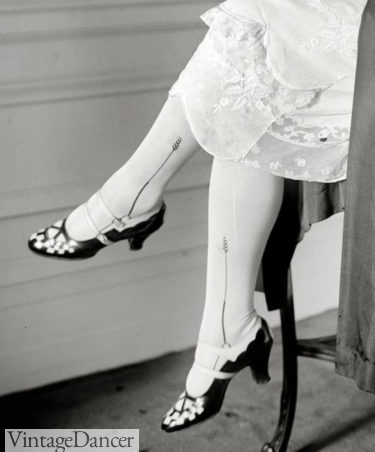
1921 clocked stockings
Nightclothes were predominantly long nightgowns with embroidery or bits of lace around the upper neckline, similar to blouses. Soft pink replaced the standard white nightgown. The Billy Burke pajama set with ruffled ankle cuffs was worn by the bright young things of the decade. Have you seen them back in style today?
- 1921 Nightgowns and pajama
- 1921 pink nightgown with embroidery
Sportswear
Women used their weekends to enjoy the outdoors, play sports and experiment with cross-dressing. Wearing breeches (knee length pants) for horse riding and hiking with tall socks and lace up boots was the only acceptable pant option for women in 1921. Paired with a button down shirts, necktie, duster coat and pith-helmet shaped felt hat- women looked nearly identical to their male companions.
Tennis was a more lady-like sport that had women wearing all white or ivory pleated skirts with blouses or white dresses with a cardigan sweater buttoned only around the low hipline. White stockings and white canvas tennis shoes (like Keds Champion shoes) created a distinct Tennis uniform.
Swimming at the beach or local river became more risque with the use of form-fitting wool swimsuits. Bathingsuits were transitioning from loose cotton swim-dresses to knit tank-top shaped swimsuits with attached undershorts. Ordinances prohibited swimwear from rising above the knee but few young women obeyed the rules.
They did, however continued to wear rolled black stockings to the knee and canvas beach shoes. Bathing beauty contests were well attended by both local beauties and spectators enjoying the views.
- 1921 Women hikers in Santa Cruz, Ca (a beach town near mountains of redwood trees.) These gals must be part of a hiking club: they are all wearing similar “club” shirts.”
- 1921 Madame D’Ora, explorer
- 1921 ad in skating clothes
- 1921 tennis outfit- a white collared dress with a cardigan sweater, white oxford shoes
- Swimsuit 1921 (tunic dress over attached shorts- All wool!)
- 1921- old style of swimdress, stockings and beach shoes
Special Events
Weddings followed the lines of fancy daytime dresses and evening gowns. Draped skirts, wide sashes, delicate embroidery, and floor length veils attached with a crown of flowers.
Ceremonies took place in churches on a Saturday morning while ceremonies may have been hosted at the bride’s family home.
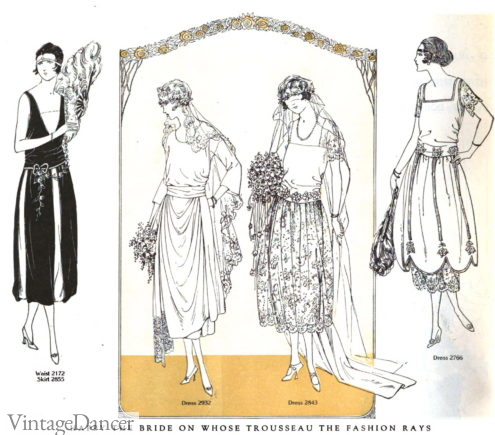
1921 wedding dresses, bridesmaid dresses
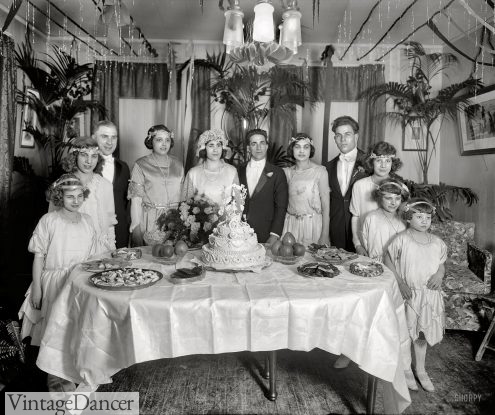
1921 Italian family wedding reception at home
Masquerade parties and children’s dress up parties (and Halloween) were frequent events hosted by community centers, bars, schools, and dance halls. Homemade costumes were always frugal and creative. Popular themes for adults and children were taken from history: 18th century (court jesters, men and women courtesans’), clowns, Greek goddesses, Arabian dancers, gypsies, Chinese men, Japanese Geishas, Dutch girls, and Uncle Sam. For Halloween, black cats, spiders, bats and birds decorated orange and black clothing or crepe paper outfits.
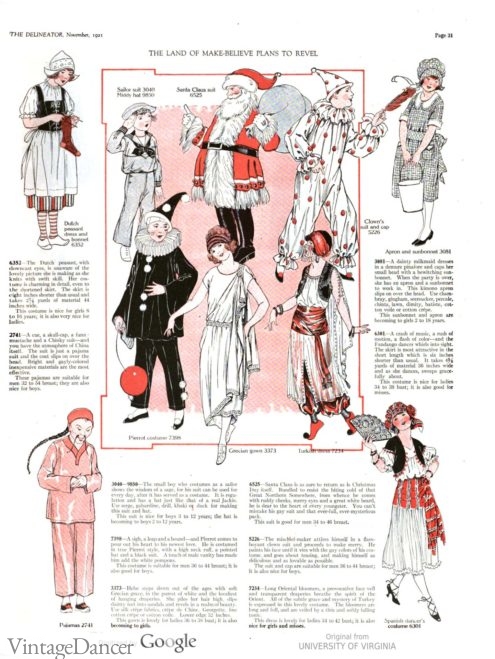
Halloween costumes- gypsies, clowns/jester, Dutch girl, Greek goddess, colonial era, Japanese and Chinese traditional dress were popular masquerade costumes for adults too.
Hats, Hairstyles
Wide-brimmed picture hats with round crowns were the thing to wear outside in summer. They were significantly smaller then the Edwardian era picture hats although the decoration was similar but less of it.
The brim was beginning to fold down on the sides framing the face like a Victorian poke bonnet (which would soon lead to the iconic cloche hat). Some front brims were folded up completely revealing the full face, like a musketeer hat. The brim was heavily decorate with flowers and ribbon motifs.
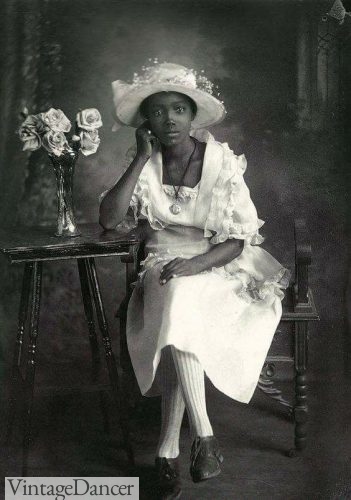
1921 white brimmed hat with flowers
The round turban hat circle the head loosely in various folds and weaves or sewn into soft points. Accents of large beads or a dangling tassel nodded to their Eastern roots.
The oversized beret hat was especially popular in winter among young women. Otherwise a knit cap with pom pom was a winter classic. More about 1920s hats here.
- 1921 brimmed hats and turban
- 1921 wide brim spring hats
- 1921 spring wide brim hats
- 1921 bonnet shaped hat
Hairstyles in 1921 mimicked the bobbed short haircut, yet most women were not ready to chop off their hair. Instead long hair was gathered back into a flat chignon bun or braided arrangement at the neck. The sides were pulled out to create puffs of hair circling the ears. Wispy curly bangs were full and frizzy although the smooth look was starting to replace that style.
Waves and crimping were still being used as a method to make straight hair curl. The waves were arranged close to the head and the most volume covered the ears.
Black women used hot oil combing to straighten hair and then arranged it in the ear-muff shapes.
Evening hairstyles were bigger and curlier than daytime looks, with adornments of strands of ribbon or pearls, tortoiseshell hair combs poking out from a bun, and headbands circling the head or across the forehead. The iconic flapper headband was beginning to trend in 1921.
- Constance Talmadge faux bobbed hair with friz
- 1921 smooth, center parted hair of faux bob
- 1921 The Dent sisters straighten and sculpted hair
- Marion Davies evening updo with ribbons
- Wave crimpers were still being used to add volume to straight hair
- 1920 very long straight hair gathered into a large bun with side draped pieces

1921 Evening Curly Hairstyles for Long Hair
Women’s Shoes
Footwear for women had the short hemlines of dresses to thank for the trend of low heel shoes instead of tall lace-up boots. Boots were still worn by some mature women in black, brown or white canvas, but the slipper/pump/heeled shoe and lace up oxford were what most young women wore everyday.
Shoes had short curvy heels called French heels. The straight Cuban heel was used on sport shoes and walking oxfords. Toes were very pointed on dressy and casual shoes. Dress heels could be slip on pumps with high vamps or 1 to 3 straps with side buttons. Laces and bows were made of silk ribbon on dress shoe.
More about 1920s shoes and boots.
- 1921 boots and strap shoes
- 1921 tall lace-up boots
- 1921 daywear shoes
- 1921 pump shoes and oxfords
- 1921 boots and stockings
- 1921 shoes and stockings
More women’s 1920s fashion: Makeup, handbags, jewelry, gloves and miscellaneous accessories
Want to know more about women’s 1921 fashion ? Ask me!
Men’s Fashion 1921
Men’s fashion in 1921, like that of women’s wear, looked to the youth to find a new post-war style. A new line of young-men’s clothing with more color, a slim fit and relaxed tailoring was inspired by the thousands of young men who came home from the war and demanded new clothing that fit their lean shape. They turned up their nose at father’s stuffy old suits, finding new inspiration from Jazz music, dancing and fast cars. “A whole generation had been infected by the eat-drink-and-be-merry-for-tomorrow-we-die spirit.”- Only Yesterday.
While menswear had long looked to London designers to set the style for the year, American designers made them more casual, sending them back to London for the next season’s inspiration. The Americans were quick to demand more casual clothes, adopting workwear into everyday styles. In the trenches they wore flexible knitwear and soft collar shirts, two things which made their way in early 20s men’s fashion.
Today you may notice several similarities between 1921 and 2021 fashion. Slim fit suits have been back in style for years while knitwear-sweaters and cardigans- seem to be making a comeback as well. The workwear look is also trending with the use of collarless shirts, denim chore jackets, suspenders, and golf caps. I expect to see much more of these looks entering the mainstream in 2021.
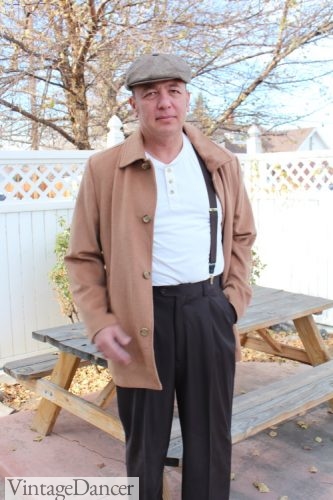
Inspired by 1921 fashion for a vintage casual 2021 style
Suits
The over-padded and oversized men’s Edwardian era suit was replaced by the slim fitting “boyish” Jazz suit. Jackets and trousers were narrow up and down the figure. A pinched high waist counter balanced a soft shoulder, slim arm and short jacket that elongated legs, a must for the agility needed to dance the energetic Charleston dance moves with young girls. The suit of 1921 is remarkably similar to today’s Skinny Suit which was copied from the mod 60s that copied the Jazz Suit. In each era, the focus on youth, was the style leader.
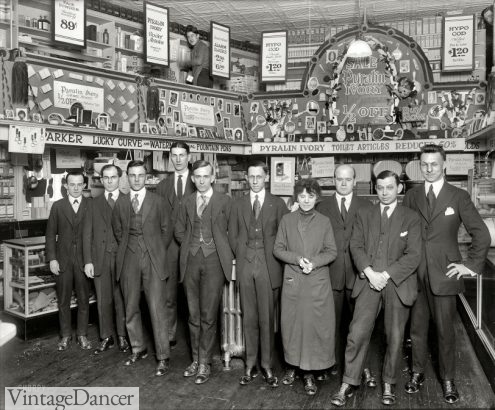
1921 men in suits working at a drug store
Some difference between modern suits and jazz suits were three-quarter back belt jacket with a deep center-vent flared skirt, open vent sleeve cuffs, a close set of button closures and a deep roll shawl collar. They could be either single or double breasted with a matching four pocket, five button vest with deep points. Trousers were very narrow, cuffed and breaking an inch or two above the ankle. Fabrics for young men’s suits had brighter colors (but overall very drab) and small but noticeable patterns of stripes, windowpane, and chevron.
- 1921 men’s young look suits (Canada)
- 1921 men’s summer suits
- Kuppenheimer Young Men’s Suits
- 1921 young men’s suit fabrics
For the not-so-young conservative man there was another suit developed for his mature taste. It was like the sack suit of the previous decade with straight closed-back jacket, curved edges, natural shoulder, flap hip pockets, angled chest pocket, and wide notch lapels. The jacket had 3 buttons while the matching vest had 5-6 buttons without lapels. Trousers were a more reasonable classic width that breaked at the shoe uncuffed. They came with belts loops but could also be worn with suspenders. Fabrics were dark blue, brown, grey solid or very subtle pattern wool suiting.
- 1921 (Candace, député de la Guadeloupe et Diagne )
Men of all ages wore suits daily. Working class men were lucky to own a 3 peice matching suit to wear on Sundays- most made do with a mismatced suit purchased second hand. Middle and upper class gentlemen owned several suits for each season.
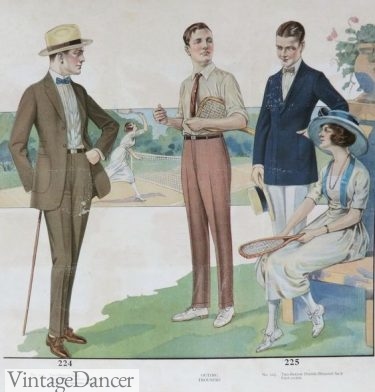
1921 men’s summer casual suits and seperates
The summer season was the time to discard vests and wear lightweight summer wool cloth suits in white, ivory or tan colors. Pairing a blue blazer with white pants was also a classic summer look, especially for yachting. This was about as casual as most gentlemen dressed unless playing a sport.
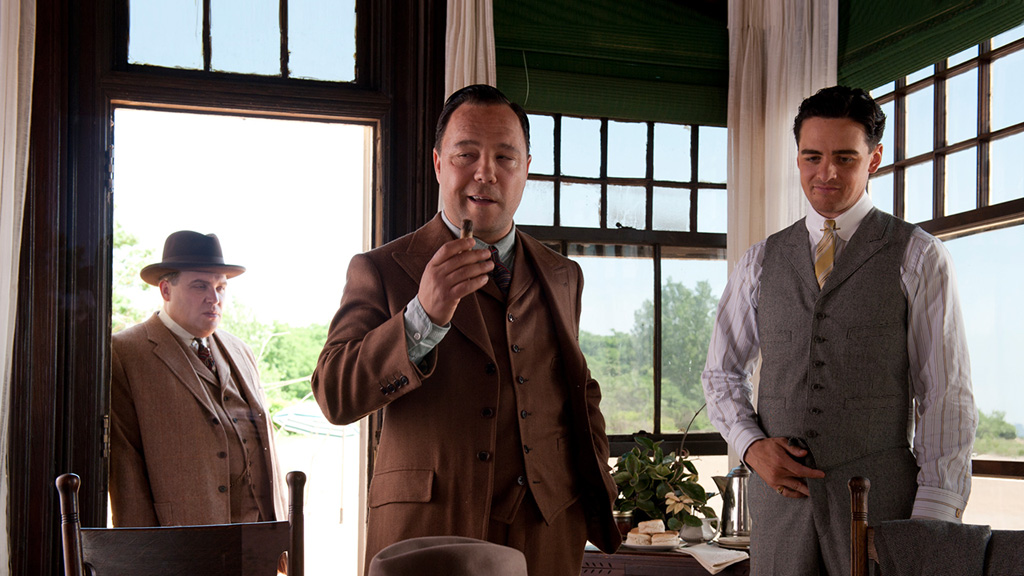
Boardwalk Empire set in 1921 with custom made suits of the era
For a look at men’s formalwear, tuxedos and morning suits read this article.
Dress Shirts and Ties
While suits were on the dull side, men’s dress shirts were a rainbow of color. Vertical thin striped shirts on a white ground came in a mix of blues, greys, black, pinks and purples. They had white collars either pointed or more commonly the rounded edge club collar. By 1921 most American men had converted to soft un-starched collars over stiff collars. Some were colorful stripes instead of white and some came attached to the shirt although this meant frequent laundering and replacement due to soiled collars.
Soft collars were prone to popping up and out of place. Collar bars, collar pins and collar stays were used to hold them down and ad some richness to the wearers accessories.
Dress shirts came in two styles. One was the pull-over with long button plaquette that reach the top of the trousers. The other was the “coat style” that buttoned all the way down, like today’s shirts. Both styles has an optional single chest pockets. Fancy silk dress shirts with French cuffs were designed to be worn with monogramed cuff links.
- Stripe dress shirts with white collars
- 1921 mens silk/cotton dress shirts
- Round “whip” collar
- Pointed collar with collar bar and tie
Neckties and bowties were the two choices men had to wear with suits. The four in hand necktie could be a wide “cravat” tie or a skinny 2.5 inches width. It extended down the chest only about 3/4 of the way to the beltline. They were bold colors with all over prints of paisley florals, dots, and stripes.
Bow ties were considered “old men” ties although some young men wore them with summer suits. The clip on tie was a newer invention. Polka dots were an epically popular bow tie pattern.
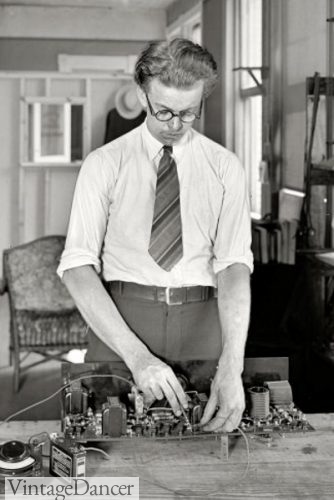
1921- A short tie by today’s standards
- 1921 men’s shirt and wide Cravat tie
- 1921 Clip-on bow ties
- 1921 men skinny stripe tie with tie pin
- 1921 Green waves Christmas tie
Coats
Outerwear was designed to fit over the new, slim Jazz suits as well as conservative suits. The shape was vertical tubes with broad shoulders and wide lapels. The hemline hovered around mid-shin to below the knee, making them much easier to walk in than previous decades. In winter, all fur coats were desired by the wealthy college kids while fur or shearling lined coats with fur collars was a bit more affordable for the upper and middle class masses.
The sport style trench coat continued to be the favorite with young men or for rainy weather use. Even it had an overall heavy and oversized appearance with wipe lapels, large pockets, wide belt, inverted pleat back and turn back cuffs. While the suits underneath were meager, the overcoats were excessive.
- 1921 men’s Chesterfield coat
- 1921 mens overcoats
- 1921 men’s trench coat
- 1921 fur collar and fur lined overcoats
Casual Separates / Workwear
Not all men dressed in suits and fancy striped shirts. The majority of working class men wore what we would call casual clothes on a daily basis. Upper class men wore them too for playing sports or lounging at home on the weekends. Paired with a knit sweater they were very colorful outfits, comfortable and more affordable.
Knitwear in the form of button down cardigans, pullover shawl collar sweaters, rollneck jersey sweaters, and sweater vests added not only comfort but bright colors to young men’s outfits. They were usually layered over a shirt and tie even in casual settings. Lower class working men may have worn a sweater instead of a jacket over a work shirt and no tie.
- 1921 sweaters and cardigans
- 1921 knit sweaters, vests and cardigans
Men’s workwear and sport shirts were solid colors in wool, flannel, corduroy or a thick cotton. They had attached soft collars and one or two flap chest pockets. Like dress shirts that either came in the pullover or coat style.
Men’s work pants never went to the narrow Jazz look. Wide legs, high waists in durable fabrics were essential to long life clothing. Wool, moleskin, corduroy, cotton twill and denim were the preferred work pant fabrics, usually in dark colors. There were also overalls and coveralls for heavy duty workwear in dark blue denim, striped denim or heavy cotton twill. Many came with a matching denim jacket.
- 1921 men’s flannel work or leisure shirts
- 1921 men’s work or casual pants
For sports or certain managerial outdoor occupations, men wore breeches or jodphurs, pants that ballooned out around the hip and cuff just below the knee. They were worn with tall socks and lace up over-the-calf boots or puttees (gaiters.) They were frequently worn for hiking, hunting, riding, golf and even by movie directors. They may look funny to use now but back then they were a prized outfit.
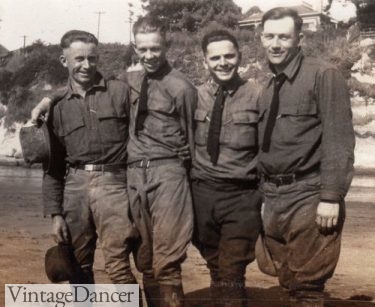
1921 a group of hikers in Santa Cruz, CA wearing breeches, sport shirts and ties. (See the matching women above)
Casual or workwear jackets in winter favored the plaid Mackinaw jacket with self fabric belt. The shearling lined heavy jacket was necessary to keep the winter cold out.
- 1920-21 Mackinaw jackets
- 1921 workwear denim overalls and jackets
More about men’s working class clothing here
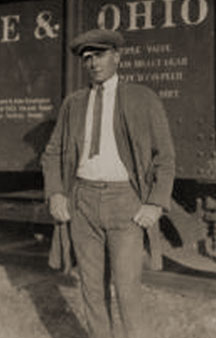
Men’s pants were either dress trousers or work pants. There was not an in-between style. For gentlemen who wanted to dress in separates but not look lower class there were extra trousers he could buy. These were frequently striped trousers with a center leg crease, high waist, belt loops and an optional cuff. They were made of midweight wool serge, cotton, or cashmere. In summer, white, tan or ivory could be worn in lighter weight wool or cotton blends.
- 1921 casual separates for gentlemen
- 1921 men’s summer casual suits and seperates
Men’s Hats
Men always wore hats. With a suit it was a felt hat in winter and a straw hat in summer. For the working classes the soft cap was the preferred and affordable hat. From formal to informal the hat styles were:
- Top Hat– For very formal evening attire, worn with white tie / tuxedo
- Felt Homburg – The early 20s homburg was shorter than previous year, with a rounded center dent, dented sides and slightly rolled narrow brim. Ideal for older business men. Dark colors: black, brown, grey, green.
- Derby hat– the hard rounded derby/bowler hat in black, brown or gray remained the British business man’s hat. Americans were done with them by 1920.
- Snap Brim fedora hat was for young men. A wide brim that could be snapped up or down in front, side or back. Front down and back up was the most common. They had a center dent top and indented sides with a very wide hat band. Mostly dark colors.
- Straw boater or sailor– a flat oval crown and stiff round brim with wide striped hat band and flat bow in colors to reflect a collage or club. Soft straw panama hats were worn by the rich.
- Golf caps-A soft fabric cap sewn with 8 triangles pieces flopped over the head and ears with a stiff brim in the front. Tweed, check, plaid and herringbone patterns in brown, green and blue or mixed colors.
- Working classes also had cadet style caps, Carlsbad western hats, planter straw hats or last’s years nice felt hat, almost worn out.
- Young college age men (with nicely groomed hair) and vacationing sunbathers were leading a gradual trend towards hatlessness.
- More men’s hats history and etiquette
- 1921 felt hats
- 1921 straw hats
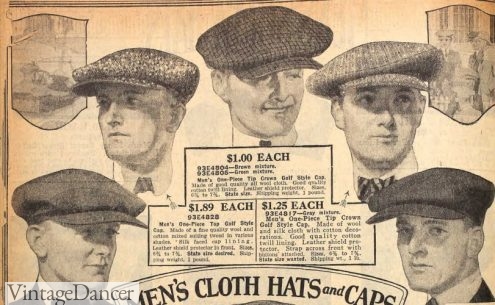
1921 golf caps
Men’s Shoes
There were only two primary styles of footwear for men in 1921. Lace up boots and oxford shoes. Both featured a narrow foot with a spade shaped sole with pointed toe, low heel, cap toe decoration or wingtips for the very fancy. Brown or black were year-round colors and white in summer worn with white suits or trousers. More about men’s shoes.
Working classes wore boots with a wider fit and round toe. In winter rubber overshoes or felt+ rubber buckled boots kept rain and snow off socks.
- 1921 lace up boots
- 1921 men’s oxfords, dress boots and work boots
Men’s Underwear and Pajamas
Boxer shorts and undershirts were not invented yet. Instead men wore one piece wool or cotton knit unionsuits. Long or short arms and long legs for winter and short legs and sleeveless arms in summer. They buttoned up the front with a button up butt flap in the back. Under dress shirts they looked like a modern Henley shirt.
- 1921 mens union suits underwear summer
- 1921 men’s winter union suits
Men’s pajamas and nightshirts were designated sleepwear for men, although many men choose to sleep in only their underwear. Both nightshirts and pajama tops came in 3 designs: V neck pullover, button down, and Asian wrap over with frog clasps. They could be solid white or blue cotton or the increasingly popular striped patterns.
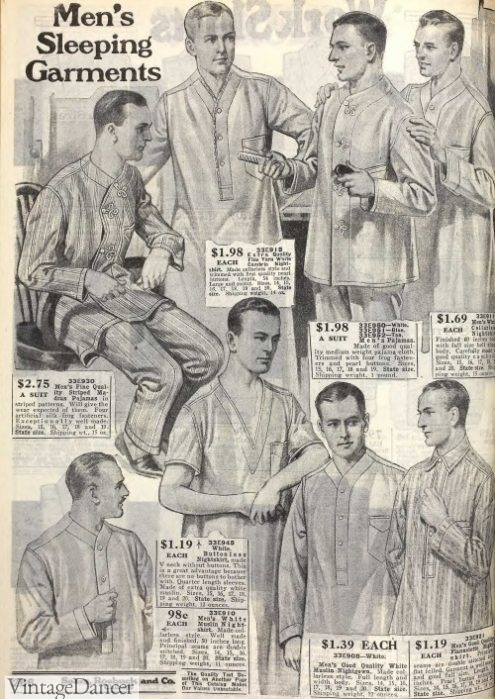
1921 men’s pajamas
When a man got home for the night he took off his suit and put on his robe and a favorite pair of house slippers. His robe was an elaborate pattern blanket cloth fabric (or silk for the rich), large shawl collar, oversized pockets and a tassel tie belt. A shorter house coat also called a smoking jacket could be worn over a suit or shirt and tie set to a casual dinner at home or lounging by the fire. It was made of suiting material with contrasting fabric for cuffs, collar and pockets.
- 1921 men’s wool underwear and robe
- 1921 men’s house robes
House slippers were leather or felt slip on loafers, opera loafers or elastic side Romeo boots. I am happy to see the classic loafer (called a smoking shoe) being sold again, although it is an everyday shoe, not exclusively a house slipper.
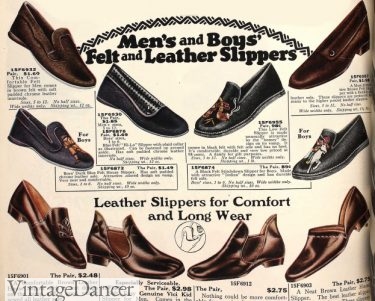
1921 men’s slippers
Men’s Hair
Young men’s hairstyles favored the longer top, shorter sides, with a center or side part and a lot of hair oil. Older men stuck to their shorter allover hairstyles and bushy mustaches, goatees or clean shaven looks.
- F Scott Fitzgerald. 1921 sported the center part hairstyles
- Dr. Emil Coué with mustache and goatee
And that wraps up 2021. While not every aspect of fashion is covered this gives you an idea of how most people dressed in daily life. If you have more questions about the years, the decade or fashion trends inspired by the past, ask me anytime.
Debbie Sessions has been teaching fashion history and helping people dress for vintage themed events since 2009. She has turned a hobby into VintageDancer.com with hundreds of well researched articles and hand picked links to vintage inspired clothing online. She aims to make dressing accurately (or not) an affordable option for all. Oh, and she dances too.
